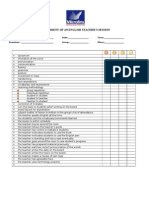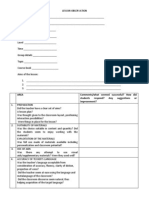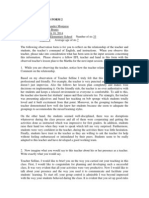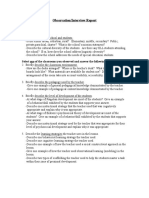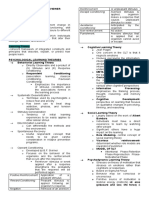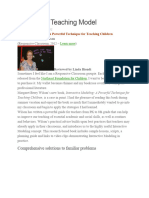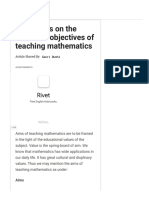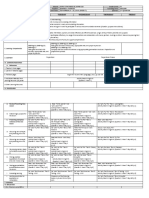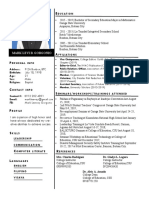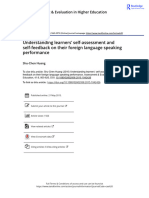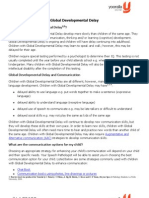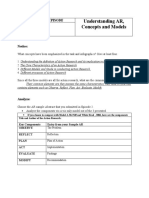WATCHING CLASS N°
SCHOOL: _________________________________________
DATE: ____________________ TIME: ____________________
COURSE: ____________________
TEACHER____________________
REPORT:
CLASSROOM
The classroom environment was perceived as [describe the general atmosphere: e.g., dynamic,
quiet, with moments of tension and relaxation]. The seating arrangement [describe the
organization: e.g., was in traditional rows, in groups, in a U-shape] and seemed [evaluate if it
was conducive to learning: e.g., to facilitate interaction, to limit visibility, etc.]. The resources
available [list the observed resources: e.g., whiteboard, projector, maps, etc.] were [evaluate
their accessibility and use: e.g., within the teacher's reach, integrated into the lesson, not
being used]. Regarding classroom management strategies, the teacher [describe the observed
strategies: e.g., maintained eye contact, used a firm but kind tone of voice, etc.] and the
behaviour of the group was generally [describe the general behaviour: e.g., attentive,
participative, with some moments of distraction]. The decoration of the classroom [describe
the presence of student work: e.g., displayed students' work on the walls, did not present
learning-related decorations, etc.].
STUDENTS
Regarding student engagement, their participation was [describe the level of participation:
e.g., active, passive, selective] and their responses to the activities were [describe the
responses: e.g., enthusiastic, reluctant, mostly correct]. For motivation, the teacher employed
strategies such as [describe the observed motivation strategies: e.g., verbal praise, playful
activities, connection to their interests]. Behaviour management was carried out through
[describe the behaviour management techniques: e.g., reminders of the rules, redirection of
attention, individual intervention].
Concerning the students' use of language, it was observed that during group work they used
English to [describe the use of English: e.g., communicate with each other, complete the
assigned tasks, with some hesitations]. The use of the mother tongue during class was
[describe the frequency of mother tongue use: e.g., minimal, frequent, allowed in certain
instances]. Problems with grammar were identified in [mention general examples if any: e.g.,
verb conjugation, the use of prepositions] and problems with pronunciation in [mention
general examples if any: e.g., certain phonemes, intonation]. Student interaction was [describe
the quality and frequency of interaction: e.g., fluent and collaborative, limited to tasks, scarce].
The time on task seemed [evaluate time on task: e.g., adequate, with moments of distraction,
�mostly focused]. Questioning behaviours on the part of the students were [describe student
questions: e.g., frequent and relevant, scarce, focused on understanding instructions]. Student
to student talk [describe conversation between students: e.g., was active during group
activities, was limited to task aspects, was not observed].
TEACHER
The lesson structure unfolded as follows: the class opened with [describe the opening: e.g., a
brief review of the previous topic, a thought-provoking question, a warm-up activity],
developed the topic through [describe the development: e.g., the presentation of new
grammar followed by practical exercises, a reading comprehension activity, a group discussion]
and closed with [describe the closing: e.g., a recap activity, the assignment of homework, a
final round of questions]. The lesson consisted of [mention the number] activities and the links
and transitions between the activities were [evaluate the transitions: e.g., smooth and clear,
abrupt at times, with explanations to connect the topics].
Regarding the type of teaching activities, whole-class activities such as [examples of whole-
class activities: e.g., explanations on the board, questions directed to the whole group] were
observed. Pair and group activities such as [examples of pair and group activities: e.g., solving
exercises, discussing a topic, role-play] were also implemented. Finally, there were moments
of individual activities such as [examples of individual activities: e.g., completing a worksheet,
writing an answer].
Concerning the teacher's use of language, their instructional language was [evaluate
instructional language: e.g., clear and concise, sometimes complex for the level, mostly in
English]. The use of questions was [evaluate the use of questions: e.g., varied, with
predominantly closed questions, encouraging critical thinking]. Feedback techniques included
[describe the feedback techniques: e.g., immediate oral correction, general praise, pointing
out errors without giving the answer]. Explanations of vocabulary and grammar were [evaluate
the explanations: e.g., clear and with examples, too technical, using translations into the
mother tongue].
The teacher's instructional strategies showed preparation, evidenced by [describe the
evidence of preparation: e.g., the logical sequence of activities, the use of prepared materials].
The methodology employed was based on [describe the methodologies: e.g., direct instruction
for grammar, communicative approach for oral practice]. Regarding differentiation, the
teacher [describe how diversity was addressed: e.g., offered alternative tasks, provided
individualized support, no specific strategies to address diversity were observed]. There was
[evaluate whether diversity was addressed: e.g., an attempt to address diversity, little
attention to different needs].
Regarding the teacher's use of materials and resources, [list the materials and evaluate their
use: e.g., photocopies with practical exercises, the blackboard to write new vocabulary,
�speakers to play audio, pictures and cards to introduce vocabulary] were used. The use of
[mention materials not used if relevant: e.g., library books, cell phones as a resource] was not
observed.
Concerning communication, the clarity of their instructions and explanations was [evaluate
clarity: e.g., generally good, sometimes confusing, with clear examples]. The feedback
provided to students was [describe the feedback: e.g., mainly verbal and immediate, with
some written corrections, focusing on accuracy]. The teacher facilitated interaction among
students through [describe how interaction was facilitated: e.g., the organization of pair and
group work, the assignment of specific roles in activities].
Reflection Questions
After the observation, I consider that the strategies I found effective in promoting learning
were [mention the effective strategies observed: e.g., the use of contextualized examples to
introduce new grammar, the role-play activities that encouraged oral practice in a meaningful
context].
In my own teaching, I would modify or improve aspects such as [mention aspects to improve in
your own practice inspired by the observation: e.g., the way of giving feedback to make it
more specific and action-oriented, the incorporation of more activities that foster student
autonomy].
The teacher handled any challenges that arose during the lesson [describe how challenges
were handled: e.g., calmly and patiently by explaining a confusing instruction again, by
redirecting the attention of a distracted student discreetly].
The insights I can apply to my own teaching practice include [mention the applicable insights
to your teaching: e.g., the importance of varying the types of activities to maintain student
interest, the usefulness of modelling instructions before students work independently].


